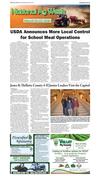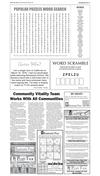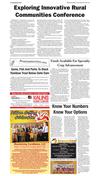032018_YKBP_A10.pdf






10 Broadcaster Press
March 20, 2018 www.broadcasteronline.com
National Ag Week
March 19-23, 2018
Using Weather Forecasts
for Newborn Calf Health
by SDSU iGrow
BROOKINGS,S.D. - Calving during a winter season
with extreme weather
swings can be concerning
when caring for newborn livestock. The Cold
Advisory for Newborn
Livestock (CANL) forecast
at the Aberdeen National
Weather Service website
can be a useful tool for
livestock producers when
preparing for new newborn
calves, in particular in the
first 24 hours.
"During the month of
January, we saw air temperatures as low as negative 30 degrees Fahrenheit
and then there were highs
of more than 50 degrees,"
said Laura Edwards, SDSU
Extension State ClimaExample of the CANL forecast map hazard areas in S.D. Courtesy: CANL
tologist. "The CANL tool was
designed to help livestock
Fahrenheit and .02-inches precipitafactors together to determine the
producers prepare for extreme cold
hazardous weather risk to your new- tion
temperatures."
• Severe: Wind Chill of -9 degrees
born calves," Edwards explained.
Created with input from Northern
Fahrenheit or colder for two or more
Visit the CANL website to access
U.S. ranchers, experts in animal scihours, or wind chill of less than 32
the tools.
ence and those who study biological
degrees Fahrenheit and .05-inches of
Risk Scale
responses to extreme weather condiprecipitation
When viewing CANL producers
tions, the CANL forecast takes into
• Extreme: Wind chill of -18 dewill see a six-category scale (Figure
account five factors:
grees Fahrenheit or colder for two or
1) which was developed to identify
• Wind chill;
more hours, or wind chill less than
the risk of hazardous conditions for
• Rain or wet snow;
32 degrees Fahrenheit and .1-inches
newborn livestock, ranging from
• High humidity;
of precipitation
None (green color) to Extreme (red
• Combinations of wind chill and
Forecast Map
color).
precipitation; and
These risk categories are disThe categories are described as:
• Sunshine vs. cloudy days.
played on a map of Northeastern
• None: Wind chill above 41 de"As a result, it is a science-based
South Dakota, and they are updated
grees Fahrenheit
method to combine several weather
at least once-per-day.
• Slight: Wind chill less than 41
An example of the CANL forecast
degrees Fahrenheit for 2 or map looks like the map in Figure
2. This map for February 13, 2018,
more hours
shows mild risk in green, moderate
• Mild:
Wind chill less in yellow over most of the region,
Six-category scale to identify the risk of hazardous conand an area of Severe risk in orange
than 32 degrees
ditions for newborn livestock. Courtesy: CANL
in the north central counties.
Fahrenheit for 2
A visit to the CANL website will
or more hours
also display the 30-hour forecasts
• Moderate:
Thanks to all involved in the Ag Industry!
for wind chill, total precipitation and
Wind chill less
sky cover (cloudy vs. clear).
than 0 degrees
Now serving the Vermillion
The CANL and related maps are
Fahrenheit for 2
& surrounding areas
or more hours or only available for regions in Montana, North Dakota and Northeastern
Wind Chill less
South Dakota.
than 32 degrees
605-670-3210
Visit us at www.jlkconstructionexcavation.com
(605) 624-6904
807 Princeton St
Two Locations
Open 24 Hours
815 Princeton St
921 E Cherry St
SDSU Extension
Research Looks
at Growing Early
Maturing Soybeans
by SDSU iGrow
BROOKINGS, S.D. - One management strategy soybean
growers can implement to reduce risk associated with
Mother Nature is to grow soybeans with varying maturity
ratings.
"With this approach, producers are not 'putting all their
eggs in the same basket' so to speak," said David Karki,
SDSU Extension Agronomy Field Specialist.
He further explained that planting soybeans other than
recommended maturity group for the region, especially
early maturing varieties, allows producers to start harvest
earlier in the fall and continue field activities such as establishing cover crops and/or timely winter wheat planting.
"Throughout recent growing seasons, growers have
commented that early soybeans have performed equally
well in terms of yield, if not better, than soybeans with
recommended maturity ratings," Karki said.
What SDSU Extension Research Has to Say
In collaboration with interested growers and the South
Dakota Agricultural Experiment Station at SDSU, SDSU
Extension established a small plot trial during the 2017
growing season at two locations in Northeast South Dakota.
The first location was at the SDSU Northeast Research
Station near South Shore. The second was in a Clark County
soybean grower's field near the town of Henry.
The trial used two early varieties (rated 0.2 and 0.3) and
two recommended varieties (rated 0.9 and 1.0) provided by
Mycogen Seeds.
All varieties were planted at two different dates:
1. May 5, 2017 which was early
2. May 23, 2017 which is when soybeans are typically
planted in the area.
The test plots were 10-feet-by-40-feet plots with four
replications for each planting date.
Due to consistent rainfall in the second half of September harvesting was delayed more than normal and was only
completed October 3, 2017.
The results featured in Table 1 show that yields, even
though numerically quite different, were not statistically
significant at the Henry location, especially for the early
planting date.
"This could be due to weed pressure and population
loss as a result of heavy rainfall in late June," said Anthony
Bly, SDSU Extension Soils Field Specialist.
He explained that this site received 9-inches of rain in
three days the last week of June, which flooded almost half
of the early planted plots.
Some early flooded plot yields were not as consistent at
harvest compared to the non-flooded plots.
Therefore, the yields from flooded plots were not used
while running statistics which may have contributed to
large Least Significant Difference (Table 1). This resulted
in difficulty to statistically distinguish mean yields for the
maturity ratings used in the study.
At the Northeast Research Station, yields from the earliest maturing soybean variety (i.e. 0.2) were significantly
different from the other three soybean varieties for both
plating dates.
"These results suggest that planting soybean varieties
that are earlier than half the maturity point than recommended for the region did not result in equal or higher
yields in 2017 growing season," Karki said.
This research group plans to continue this study in
the 2018 growing season. The study was funded by South
Dakota Soybean Research and Promotion Council.
FIRST DAKOTA
Irrigation
Sales & Service
Irrigation PVC, Wire Installed, Well Drilling Domestic & Irrigation Pump Installation
WATERLINE & ELECTRIC TRENCHING
Tree & Concrete Removal, Site Clearing,
& Ditch Trenching
ALL TYPES OF DIRT WORK - FREE ESTIMATES
Bobcats • Crane • Dozers • Excavators • Grader
Grain Trailer • Scrapers • Side Dumps • Trenchers
Vermillion, SD (605)670-9567
Hartington, NE (402)254-2568
Licensed in SD, NE & IA
SALUTES
AGRICULTURE
PROUD TO SUPPORT OUR LOCAL PRODUCERS
First Dakota National Bank salutes the families and businesses
who work hard every day supporting the Ag industry. Without
you, we would not have the land for a resource or be able to
enjoy our quality of life.
Thank you for all you do!
624-5555
1110 E Cherry Street :: Vermillion
FirstDakotaAg.com



















 Previous Page
Previous Page






